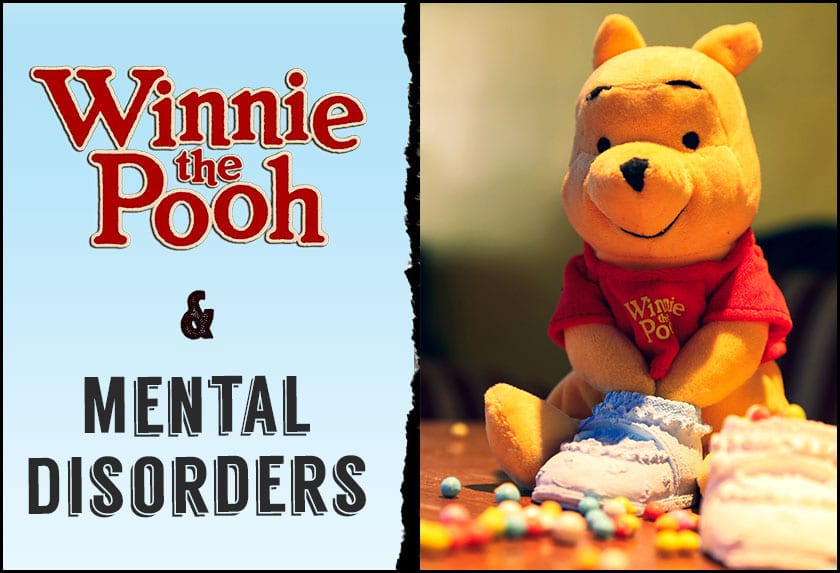Uncovering Winnie The Pooh's Mental Disorders: A Deep Dive
Can a children's story, seemingly brimming with innocence, actually offer profound insights into the complexities of mental health? The residents of the Hundred Acre Wood, far from being mere whimsical characters, may, in fact, serve as surprisingly relatable embodiments of various psychological conditions.
From the outset, one might casually consider the character of Winnie the Pooh, that perpetually honey-loving bear, as simply endearing. However, a closer look reveals a more nuanced portrayal, one that resonates with the realities of mental health struggles. Research, in fact, has begun to draw meaningful connections between the beloved characters of A.A. Milne's classic and various psychological disorders, offering a unique lens through which to understand the human experience. The narratives, while never explicitly diagnosing the characters, subtly hint at underlying behavioral patterns that mirror real-world mental health challenges. This article delves into these fascinating parallels.
Winnie the Pooh Character Analysis
The following table explores the characters of the Hundred Acre Wood and their potential correlations to mental health disorders:
| Character | Possible Mental Health Disorder(s) | Behavioral Traits |
|---|---|---|
| Winnie the Pooh | Attention Deficit Hyperactivity Disorder (ADHD), possible Obsessive-Compulsive Disorder (OCD), Eating Disorder | Inattentiveness, impulsivity, disordered thoughts, forgetfulness, preoccupation with food. |
| Piglet | Generalized Anxiety Disorder (GAD), possibly Post-Traumatic Stress Disorder (PTSD) | Chronic worry, hypervigilance, low self-esteem, easily frightened. |
| Eeyore | Depressive Disorder (Dysthymia or Major Depressive Disorder) | Pessimism, low energy, social withdrawal, sadness, hopelessness. |
| Tigger | Attention Deficit Hyperactivity Disorder (ADHD) or Bipolar Disorder (manic phase) | Hyperactivity, impulsivity, distractibility, excitability, excessive optimism. |
| Rabbit | Obsessive-Compulsive Personality Disorder (OCPD) | Rigidity, orderliness, control issues, perfectionism, adherence to rules. |
| Owl | Potential for Narcissistic Personality Disorder (NPD) or grandiosity | Pompous, arrogant, self-important, falsely perceives themselves as intelligent and knowledgeable. |
| Kanga | Overprotective tendencies, anxiety disorders | Hyper-vigilance for Roo, anxious about the well-being of others |
For more detailed information, you may reference the research conducted by Shea and colleagues (2000), among others. Please note that while this table provides a framework for understanding, it's crucial to consult with qualified mental health professionals for proper diagnosis and treatment.
Link to a related and authentic website: VeryWellMind Article
Winnie the Pooh, at the heart of this exploration, displays behaviors that align with Attention Deficit Hyperactivity Disorder (ADHD). His tendency towards inattentiveness, scattered thoughts, impulsive remarks, and persistent forgetfulness are all hallmarks of the inattentive subtype of ADHD. Furthermore, Pooh's unwavering focus on honey, and his impulsive drive to obtain it, might subtly suggest the presence of an eating disorder or Obsessive-Compulsive Disorder (OCD) tendencies.
The character of Piglet, often depicted as anxious and easily frightened, embodies the characteristics of Generalized Anxiety Disorder (GAD). His chronic worry, heightened vigilance, and low self-esteem resonate with the experiences of individuals grappling with anxiety. Additionally, given Piglets vulnerability and frequent distress, it can be hypothesized that he might represent or be going through Post-Traumatic Stress Disorder (PTSD).
Eeyore, with his perpetual gloom and pessimistic outlook, vividly personifies the features of a Depressive Disorder, potentially Dysthymia or Major Depressive Disorder. His social withdrawal, lack of energy, and feelings of hopelessness paint a poignant picture of the struggles associated with depression.
Tigger's boundless energy, impulsivity, and penchant for bouncing may correlate with ADHD, or potentially the manic phase of Bipolar Disorder. His exuberant enthusiasm and difficulty staying focused parallel the challenges faced by individuals with these conditions. Hes always bouncing, always eager to try new things, and rarely considers the potential consequences of his actions.
Rabbit's meticulous nature and unwavering adherence to order hint at Obsessive-Compulsive Personality Disorder (OCPD). His need for control, perfectionism, and rigid adherence to rules reflect the traits commonly associated with this condition. Rabbit is always planning, organizing, and ensuring that everything is "just so" in the Hundred Acre Wood.
Owl, with his self-proclaimed wisdom and tendency to pontificate, might subtly embody characteristics of Narcissistic Personality Disorder (NPD). His pompous demeanor, and inflated sense of self-importance, suggest a potential disconnect from reality, and his propensity to be perceived as the "wise" character can make him arrogant.
Kanga's overprotectiveness towards Roo can be seen as an indicator for underlying anxiety. Always prioritizing Roo's well-being and exhibiting some hyper-vigilance, Kanga is a motherly figure with a lot of anxiety.
It's important to remember that these are observations and interpretations. The narratives within the Winnie the Pooh stories were not designed to serve as clinical diagnoses. Milne's creation, however, provided the chance to begin conversations surrounding mental health. The intent was not to diagnose, but to entertain, to touch the hearts of young readers, and to explore themes of friendship, acceptance, and the complexities of human nature.
The relevance of mental health awareness is undeniable, and the characters of Winnie the Pooh, with their distinct personalities and relatable struggles, can play a pivotal role in simplifying these complex conversations. When we discuss the behaviors of Pooh, Piglet, Eeyore, and Tigger, we are, in a way, creating an easy pathway to talk about the mental health of many people. When children and adults can recognize traits within characters, this makes the discussion of mental disorders more accessible, less intimidating, and can help decrease the stigma associated with mental illness.
The conversations surrounding mental health are as important as ever. While the stories were initially created for children, the characters have become a source of inspiration. The lasting impact of Winnie the Pooh on mental health discourse is a testament to the power of storytelling and the enduring appeal of these beloved characters. By using the characters of the Hundred Acre Wood to better understand and discuss mental health, we can offer a unique, relatable, and compassionate perspective on what it means to be human.
One cannot deny the depth of the stories, and the unique perspectives on mental health that they offer. It's a testament to the power of storytelling, and the enduring appeal of these beloved characters. The world of Winnie the Pooh continues to inspire, not just because of the stories, but because the characters provide us with a chance to address complicated issues, like mental health. This opens the door to understanding, and acceptance, which is invaluable in these times.


